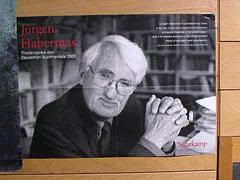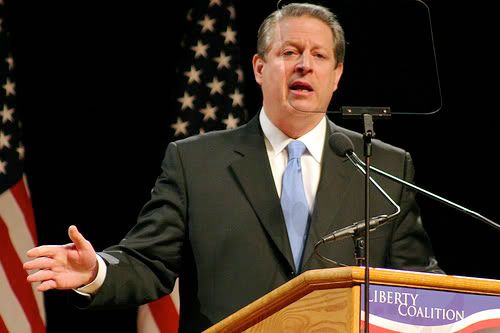Promoted by Steven D.
(Crossposted at DailyKos)
Al Gore’s The Assault On Reason is largely an extended critique of the Bush administration?s policies. But, in suggesting in his introduction that Chapters 1 through 5 of The Assualt On Reason, the first half of his book, would be about the “enemies of reason,” Gore suggests a theory of the media, of history, and of reason that identifies Jurgen Habermas’ characterization of “the refeudalization of the public sphere” as a trend of the present era of politics (18). So for this book review I will consider both Gore’s (2007) book and Habermas’s (1962, originally) book as analyses of media history. Here I will concentrate upon the similarities of Gore’s template to Habermas’s.
(Of the diaries that have been written about Gore’s book, let me grant some kudos: first to algebrateacher for trying to put together a study guide, Nonpartisan’s attempt to fit Gore into the Progressive legacy, jamesboyce’s note on E. J. Dionne, and of course teacherken’s long moving diary.)
Introduction: Al Gore’s The Assault On Reason is mostly about the Bush administration. But it’s also about, as its title suggests, “reason.” The first five chapters designate supposed “threats to reason,” such as fear, dogmatism, the conquest of the “public sphere” by the wealthy, the spread of lies, and government violations of individual rights. The concentration of all of these “threats to reason” in the Bush administration, Gore argues, leads to three negative outcomes: America is less secure, abrupt climate change threatens the globe’s ecosystems, and American democracy is threatened.
As a counterweight to the Bush administration, Gore suggests that the Internet will at some point make an effective “public sphere,” reinvigorating the “conversation of democracy”:
In fact, the Internet is perhaps the greatest source of home for reestablishing an open communications environment in which the conversation of democracy can flourish. The ideas that individuals contribute are dealt with, in the main, according to the rules of a meritocracy of ideas. It is the most interactive medium in history and the one with the greatest potential for connecting individuals to one another and to a universe of knowledge. (260)
Behind Gore’s critique of Bush, then, is a history of communication media. The introduction even contains a sustained critique of the theories of Marshall McLuhan, who was (in North America in the 1960s, at least) the world’s most famous media historian and who had a theory of “cool” and of “hot” media (20). In this history, the print media promoted a “public sphere” in an earlier era, television is a harmful enabler to Bush in the current era, and the Internet has the potential to bring back democracy to America.
The theory of the media that would seem to most thoroughly inform Gore’s notion of an “assault on reason” (and thus his critique of Bush) is that given by Jurgen Habermas in his early (1962) book Structural Transformation of the Public Sphere, whence Gore’s citation of the “refeudalization of the public sphere” on p. 18 of The Assault on Reason. Gore’s Habermasian idealism goes all the way down to his interest in the notion of the “unforced force of the better argument” (or at least in a “meritocracy of ideas” of some sort) that one sees in Habermas’ later works on argumentation. But, generally, Gore sees his work as a contribution to the “public sphere” that is mentioned in the abovecited early Habermas work. In order to see Gore?s adoption of Habermas’ (1962) historical template, I will discuss Structural Transformation of the Public Sphere and then situate the argument of The Assault on Reason within its premises.

(photo credited to mimax via creative commons)
Habermas: Habermas’s Structural Transformation of the Public Sphere can be argued in a nutshell: The historical appearance of the “public sphere” has a distant echo in Classical Athens, to be sure, but its modern appearance comes with the separation of the “public” and the “private” in the early eras of capitalism, most specifically in the 18th and 19th centuries. The “traffic in commodities and news” (17), which expands at the beginning of the capitalist era in the 16th and 17th centuries, later becomes a “public sphere” with the proliferation of newspapers, leaflets, and other forms of literary culture. The main distinction of the “public sphere,” and of the “civil society” which participated in it, was that it was a forum in which “civil society” could criticize the state. The actual places where this criticism were performed were the literary salons of early modernity and, essentially, the Victorian coffeehouse, where “public opinion” could be voiced.
Now, this historical “public sphere’ was marked by gender and class exclusions — this is why Habermas calls it the “bourgeois public sphere,” and it’s why historians like Mary P. Ryan note in Habermas and the Public Sphere that “women were patently excluded from the bourgeois public sphere, that ideal historical type that Habermas traced to the eighteenth century, and were even read out of the fiction of the public by virtue of their ideological consignment to a separate realm called the private.” But within the clubs, the coffeehouses, the salons, matters of status were disregarded (36). Generally, however, the bourgeoisie were the “public” which constituted “civil society,” with the working class peering in from the outside. Habermas goes into detail about the developments in literary life that reflected the development of the public sphere.
However, Habermas tells us that as the economy of capitalist society was transformed by the consolidation of corporate power, the “public sphere” was transformed into a mass society, in which the public and the private were no longer held separate. The most important political difference between the “public sphere” and mass society is reflected in the author’s heading, “From a Culture-Debating to a Culture-Consuming Public.” In this development, we are told that “the public sphere in the world of letters was replaced by the pseudo-public or sham-private world of culture consumption.” (160) Participation in public life, for Habermas, becomes just another form of commodity consumption, and political meaning is lost in the spatial dominance of market culture. (164) Political consensus formation in consumer society, we are told,
…ensures a kind of pressure of nonpublic opinion upon the government to satisfy the real needs of the population in order to avoid a risky loss of popularity. On the other hand, it prevents the formation of a public opinion in the strict sense. For inasmuch as important political decisions are made for manipulative purposes (without, of course, for this reason being factually less consequential) and are introduced with consummate propagandistic skill as publicity vehicles into a public sphere manufactured for show, they remain removed qua political decisions from both a public process of rational argumentation and the possibility of a plebicitary vote of no confidence in the awareness of precisely defined alternatives. (221)
Thus public opinion becomes an object of domination “even when it forces (the dominators) to make concessions or to reorient itself. It is not bound to rules of public discussion or forms of verbalization in general, nor need it be concerned with political problems or even addressed to political authorities.” (243)
Now, one can see Bush from Habermas’s (1962) perspective as someone trying to use the tools of media manipulation to make the Presidency into a complete autocracy. In Habermas’s (1962) sense, Bush is completing a trend that was there as a potential since the first days of universal access to radio or television. Bush, then, can easily be seen as the ultimate consequence of what Herman and Chomsky call “manufacturing consent.” The general insinuation of this type of history is that the public sphere was useful for the triumph of the bourgeoisie in their struggle with the old aristocracies of Europe but, once its rights had spread to the rest of the public, it became absorbed in the “consumer” dispensation described above by Habermas. So let’s see, then, what Al Gore makes of the template of the (bourgeois) public sphere.

(Photo credited to Matthew Bradley via Creative Commons)
Gore: In The Assault on Reason, Gore puts aside the class content and economic analysis of Habermas’s earlier analysis, and attempts to make a case for this historical template based on media history. Gore’s version of this history is stated in its most Habermasian vein on pp. 130-131:
African Americans, Native Americans, and women were not included in the circle of respect two centuries ago, of course. And in reality, access to the public forum was much more freely available to educated elites than to the average person. Even though literacy rates were high in the late eighteenth century, illiteracy was a barrier for many then, as it is for many Americans still.
Nevertheless, with the dominance of television over the printing press and the continued infancy of the Internet in its development as a serious competitor to television, we have temporarily lost a common meeting place in the public forum where powerful ideas from individuals have the potential to sway the opinions of millions and generate genuine political change. What has emerged in its place is a very different kind of public forum — one in which individuals are constantly flattered but rarely listened to. When the consent of the governed is manufactured and manipulated by marketers and propagandists, reason plays a diminished role. (130-131)
For Gore, the main consolation for this (generally gloomy) picture of history is the Internet, which (of course) wasn’t around in 1962 when Jurgen Habermas published Structural Transformation of the Public Sphere:
With each passing month, the Internet is bringing new opportunities for individuals to reassert their historic role in American democracy. (131)
It remains to be seen, however, what historic role in the resolution of the problems of world-historic scope (and Gore’s book is full of them) the Internet will play. (It is, after all, far cheaper to get a TV or radio than to get a computer with an Internet service provider, so we might run into some class-analysis problems in that light.)
Sure, Al Gore’s use of this historical template lacks the class analysis, the eye for political economy, that made Habermas’s (1962) book so cogent. Perhaps in this light Gore could consider how the public sphere developed in light of the domination of politics by the wealthy, and re-elaborate on his discussion at the beginning of Chapter 3 (the “The Politics of Wealth” chapter) where he starts by praising capitalism and then criticizing it. Gore:
The inner structure of liberty is a double helix: One strand — political freedom — spirals upward in tandem with the other strand — economic freedom. But the two strands, though intertwined, must remain separate in order for the structure of freedom to maintain its integrity. If political and economic freedoms have been siblings in the history of liberty, it is the incestuous coupling of wealth and power that poses the deadliest threat to democracy. (72-73)
I would ask Al Gore to consider that “capitalism” and “economic freedom” mean different things to people of different social classes. To the poorest among us, “capitalism” means the obligation to pay, and “economic freedom” means having enough money to pay, or at least to be able to make a living without being trapped in debt peonage. To the wealthiest among us, the “incestuous coupling of wealth and power” IS “economic freedom.” “Capitalism,” then, is not equivalent to “economic freedom” for everybody.
I would also like to encourage all readers of this diary, and especially Al Gore should he encounter it, to read some of the derivative works of Habermas’s Structural Transformation of the Public Sphere. My favorites:
Mike Hill and Warren Montag’s Masses, Classes, and the Public Sphere
John Forester, ed. Critical Theory and Public Life
Craig Calhoun, ed. Habermas and the Public Sphere
and of course the ever-informative
Rolf Wiggershaus, The Frankfurt School: Its History, Theories, and Political Significance
that’s enough for now.




